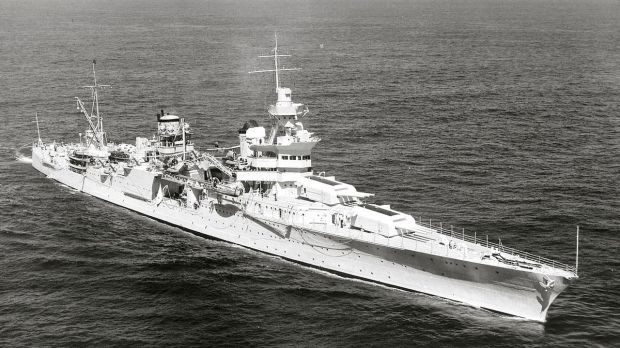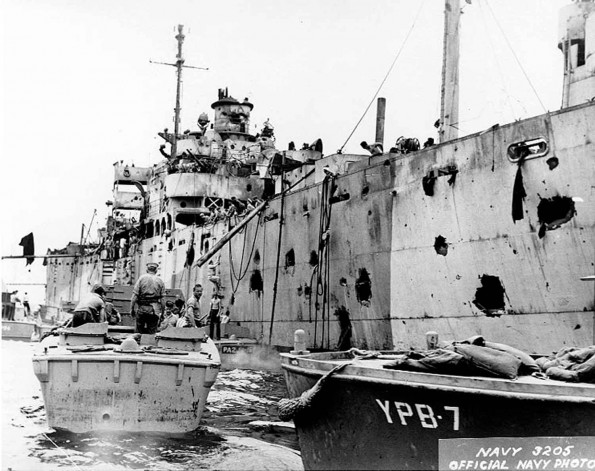
It was shortly after midnight—on the 30th of July, 1945—when disaster struck.
After delivering the Hiroshima-bomb components to Tinian Island, the USS Indianapolis and her crew of 1,196 sailors were sailing west, toward Leyte (in the Philippines).

At 00:14 on 30 July, she was struck on her starboard side by two Type 95 torpedoes, one in the bow and one amidships, from the Japanese submarine I-58, under the command of Mochitsura Hashimoto.

The explosions caused massive damage. Indianapolis took on a heavy list, and settled by the bow. Twelve minutes later, she rolled completely over, then her stern rose into the air, and she plunged down. Some 300 of the 1,196 crewmen went down with the ship. With few lifeboats and many without life jackets, the remainder of the crew were set adrift.
As the sun rose on July 30, the survivors bobbed in the water. Life rafts were scarce. The living searched for the dead floating in the water and appropriated their lifejackets for survivors who had none. Hoping to keep some semblance of order, survivors began forming groups—some small, some over 300—in the open water. Soon enough they would be staving off exposure, thirst—and sharks.
The animals were drawn by the sound of the explosions, the sinking of the ship and the thrashing and blood in the water. Though many species of shark live in the open water, none is considered as aggressive as the oceanic whitetip. Reports from the Indianapolis survivors indicate that the sharks tended to attack live victims close to the surface, leading historians to believe that most of the shark-related causalities came from oceanic whitetips.
The first night, the sharks focused on the floating dead. But the survivors’ struggles in the water only attracted more and more sharks, which could feel their motions through a biological feature known as a lateral line: receptors along their bodies that pick up changes in pressure and movement from hundreds of yards away. As the sharks turned their attentions toward the living, especially the injured and the bleeding, sailors tried to quarantine themselves away from anyone with an open wound, and when someone died, they would push the body away, hoping to sacrifice the corpse in return for a reprieve from a shark’s jaw. Many survivors were paralyzed with fear, unable even to eat or drink from the meager rations they had salvaged from their ship. One group of survivors made the mistake of opening a can of Spam—but before they could taste it, the scent of the meat drew a swarm of sharks around them. They got rid of their meat rations rather than risk a second swarming.
The sharks fed for days, with no sign of rescue for the men. Navy intelligence had intercepted a message from the Japanese submarine that had torpedoed the Indianapolis describing how it had sunk an American battleship along the Indianapolis’ route, but the message was disregarded as a trick to lure American rescue boats into an ambush. In the meantime, the Indianapolis survivors learned that they had the best odds in a group, and ideally in the center of the group. The men on the margins or, worse, alone, were the most susceptible to the sharks.
As the days passed, many survivors succumbed to heat and thirst, or suffered hallucinations that compelled them to drink the seawater around them—a sentence of death by salt poisoning. Those who so slaked their thirst would slip into madness, foaming at the mouth as their tongues and lips swelled. They often became as great a threat to the survivors as the sharks circling below—many dragged their comrades underwater with them as they died.
After 11:00 a.m. on their fourth day in the water, a Navy plane flying overhead spotted the Indianapolis survivors and radioed for help. Within hours, another seaplane, manned by Lieutenant Adrian Marks, returned to the scene and dropped rafts and survival supplies.

When Marks saw men being attacked by sharks, he disobeyed orders and landed in the infested waters, and then began taxiing his plane to help the wounded and stragglers, who were at the greatest risk. A little after midnight, the USS Doyle arrived on the scene and helped to pull the last survivors from the water. Of the Indianapolis’ original 1,196-man crew, only 317 remained.

Estimates of the number who died from shark attacks range from a few dozen to almost 150. It’s impossible to be sure. But either way, the ordeal of the Indianapolis survivors remains the worst maritime disaster in U.S. naval history.
The USS Indianapolis, led by Captain Charles McVay, was ordered to head toward Guam by going through the Leyte Gulf. What the U.S. Navy didn’t tell him was the Leyte Gulf at the time was a haven for Japanese submarines, and that ships passing through should do so with extreme caution.

Lacking the intel that he was in unfriendly waters and exercising his order to perform evasive maneuvers “at his discretion,” McVay told the crew to just head straight forward, and bid them a good night. Unfortunately the Japanese submarine I-58, captained by Mochitsura Hashimoto, noticed the Indianapolis heading straight toward it and immediately sank it.

McVay survived and World War II ended, but soon thereafter he found himself in a court martial for negligence in the sinking of his ship (probably as a scapegoat to cover for the other Navy guys who completely botched the Indianapolis’ travel instructions and subsequent rescue.
In the trial, the U.S. Navy made the fairly unprecedented step of bringing in Hashimoto as a witness . He was brought in as a witness for the prosecution, expected to talk about the gross incompetence of the American captain, hoping he would seal McVay’s fate. Rather unexpectedly, when Hashimoto took the stand he outright defended McVay, stating that no matter what he had done, the Indianapolis still would have been hit by his torpedoes.
The U.S. Navy still found McVay guilty regardless of what Hashimoto said, demoting him and basically ruining his naval career. Though Admiral Nimitz would wind up promoting McVay back to his old rank soon thereafter, the trial decision still stood — that is, until Hashimoto decided to help McVay out again. Hashimoto sent a letter to Senator John Warner, an action that helped lead to McVay being exonerated.

Donation
I am passionate about my site and I know you all like reading my blogs. I have been doing this at no cost and will continue to do so. All I ask is for a voluntary donation of $2, however if you are not in a position to do so I can fully understand, maybe next time then. Thank you. To donate click on the credit/debit card icon of the card you will use. If you want to donate more then $2 just add a higher number in the box left from the PayPal link. Many thanks.
$2.00

























You must be logged in to post a comment.